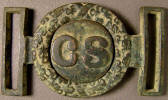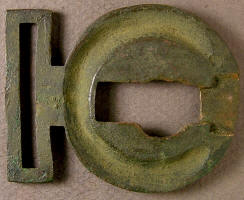
Fakes, reproductions, replicas,
an investigative report, by Harry Ridgeway
 |
Fakes, reproductions, replicas, |
Fakes, reproductions, replicas,
Disclaimer: by clicking onto this page you are expressly accepting the terms of the disclaimer explained fully on the fakes main page.
FP1487
CS two part buckle, "coin"
style




Measurement: keepers 47mm, wreath height 51mm.
Editor Note: This buckle made a brief appearance on my webpage, but was not sold and was returned to its consignor. The authenticity question is not entirely clear. This one was coated with a troublesome green coating which was clearly covering something, either a damaged patina, repair or telltale repro casting marks. The wreath shows an area "cut out" which is similar to some repro wreaths otherwise noted. This piece was rejected and returned to the seller, because of questions of this piece and the fact that the green coating had simply obscured too much of the details needed to authenticate this piece.
This buckle was returned to my source. I later saw this buckle after it was passed back further in the ownership chain, and it became the source of considerable discussion at a show. It was discovered then that the tongue, which is probably authentic, is a repair. The neck literally broke apart during the discussion exposing the epoxy gluing it together. The seller was so sure it was not repaired that he put pressure on it before witnesses to prove his point, and to his disgust it broke exposing the epoxy. The conclusion now is that the tongue is authentic but repaired.
The wreath does show a cut out area similar to some of the repros. The well on the wreath is thin, so if the casting is poor quality, the melted metal simply did not fill this area of the mold leaving this space. This spot is on the opposite side of the wreath from the similar flaw in Hanover Brass repros, so this is not a Hanover Brass repro, maybe. Or they could have cast this flaw into the opposite side intentionally. This is a detail that is very easy to misinterpret so I post it here so it can be discussed. We still have the problem that the green coating is covering important details, no telling what is underneath of that.
As a side note, it is ok to collect and sell repaired pieces. Certain repaired pieces do look better than the piece not repaired. The key is disclosure. If you know it is repaired and the price so reflects this flaw then there is nothing unethical about buying or selling a repaired piece. Often this green patina is applied to pieces to obscure repairs. It can also be used to obscure damaged or overcleaned patinas. These applied coatings can be easily removed, some with water but if not with water, paint stripper will get it every time. In this particular case, I asked the seller for permission to remove the coating, I wanted to see the actual metal as a condition to purchase. The seller did not want his buckle to be so altered so I rejected it. You need to be very careful not to alter a buckle that may be returned, most sellers, including me, will not accept a return that has been altered in any way. So if examining the details under these troublesome coatings is a condition of the sale, you need to get the sellers agreement before you remove the coating. The coating needs to come off to truly authenticate the buckle, and had it been removed in this case, the repair would have been obvious.